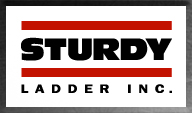Ladder Safety & Maintenance
View PDF Version
Selection:
- Select ladder of proper length to reach working height.
- Select ladder grade by projected used and load rating:
| Grade | Projected | Load Rating |
|---|---|---|
| 1 | Construction & Industrial | Heavy - 250/300/375lbs |
| 2 | Tradesman & Farm | Medium - 225lbs |
| 3 | Household | Light - 200lbs |
Before Use:
- Inspect upon receipt and before each use. Make sure all rivets, joints, nuts and bolts are tight; rungs are secure; ladder extension locks and feet are functioning (if necessary, lubricate); and rope is properly affixed and in good condition.
- Never climb a damaged, bent or broken ladder.
- Keep ladder clean and free from grease, oil, mud, snow, wet paint and other slippery materials. Make sure your shoes are clean. Leather soles should not be used.
- Never make temporary repairs of damaged or missing parts. All parts must be in good working order.
Set-Up:
- DANGER! Metal ladders conduct electricity.
- Do not let ladders of any material come into contact with electrical wires.
- Place on a firm level surface and ensure a secure footing. Do not place on boxes, unstable bases or scaffolds. Do not tie or fasten ladders together to gain additional height.
- Do not place in front of door opening toward ladder.
- Set ladder on firm ground. Do not lean sideways. Do not use on ice or snow or slippery surface without non-skid devices or securing feet.
Single & Extension Ladders:
- Secure base when raising.
- Never set up a ladder when it is extended.
- Set angle or extension at proper (75°) angle by placing ladder base at a distance equal to one-fourth total working length of ladder away from base of vertical support.
- Erect ladder with minimum 3 ft. extending above roof line; tie top at support points.
- Extend top section only from ground, never by "bouncing" or from the roof.
- Do not over-extend. Maintain minimum overlap of sections.
Stepladders:
- Make sure ladder is fully open, spreaders are secure and pail shelf is in position.
Climbing & Use:
- Do not use ladders if you tire easily, are subject to fainting spells, are using medicine or alcohol, or are physically handicapped.
- To protect children, do not leave ladders set up and unattended.
- Securely engage ladder-locks before climbing. Check that top and bottom ends of ladder rails are firmly supported.
- Face ladder when climbing up or down. Do not over reach. Keep body centered between side rails. Move ladder as needed.
- Where possible use second person to hold ladder.
- Maintain a firm grip. Used both hands in climbing.
- Do not climb ladder from the side unless secured against side motion. Do not climb from one ladder onto another.
- Do not use ladder in high winds.
- Never use ladder as a platform, plank or hoist. Never use ladder on a scaffold.
- Do not overload; ladders are meant for one person only.
- Keep ladder close to area of work. Avoid pushing or pulling off to the side of the ladder.
- Never drop or apply an impact load to ladder.
- Do not "walk" or shift ladder while standing on it.
Care & Storage:
- Hang ladder on racks in dry place at intervals or 6 ft. for support.
- While in transit, avoid long overhang beyond support points. Ladders that are frequently transported on vehicles should have mounting points covered with soft material to reduce chafing and road shocks. Ladder feet, if free to swing, should be secured to prevent constant movement while the vehicle is in motion.
- Never store materials on ladders.
- Never paint a wood ladder; treat it at frequent intervals with wood preservative or clear coating.
- Keep ladder clean and free of all foreign materials.
- Destroy ladder if broken, worn or exposed to fire or chemical corrosion.
- Plastic reinforced ladders may be affected by prolonged sunlight exposure which can cause glass fibre prominence. If this occurs, the ladder can be cleaned with a suitable solvent or detergent and coated with acrylic lacquer or polyurethane.
